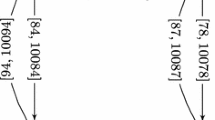Abstract
This paper presents a heuristic algorithm for the earliest arrival flow problem. Existing exact algorithms, even polynomial in the output size, contain submodular function optimization as a frequently called subroutine, and thus are not practical in real-life applications. In this paper we propose an algorithm that does not involve the submodular function optimization. Although solving an EAF near-optimal, the algorithm is remarkably simple and efficient as it only involves shortest path computations on a static network. A numerical example illustrates how the algorithm works. As an application, we demonstrate the algorithm’s solution quality and computational performance by solving a real-size network.
Similar content being viewed by others
References
Ford, Jr., L.R., Fulkerson, D.R.: Constructing maximal dynamic flows from static flows. Oper. Res. 6(3), 419–433 (1958)
Aronson, J.E.: A survey of dynamic network flows. Ann. Oper. Res. 20, 1–66 (1989)
Bookbinder, J.H., Sethi, S.P.: The dynamic transportation problem: a survey. Nav. Res. Logist. Q. 27(3), 447–452 (1980)
Skutella, M.: An introduction to network flows over time. In: Cook, W.J., Lovasz, L., Vygen, J. (eds.) Research Trends in Combinatorial Optimization, pp. 451–482. Springer, Berlin Heidelberg (2008)
Fleischer, L., Tardos, E.: Efficient continuous-time dynamic network flow algorithms. Oper. Res. Lett. 23(3–5), 71–80 (1998)
Gale, D.: Transient flows in networks. Mich. Math. J. 6(1), 59–63 (1959)
Philpott, A.B.: Continuous time flows in networks. Math. Oper. Res. 15(4), 640–661 (1990)
Fleischer, L.K.: Faster algorithms for the quickest transshipment problem. SIAM J. Optim. 12(1), 18–35 (2001)
Fleischer, L., Skutella, M.: Quickest flows over time. SIAM J. Comput. 36(5), 1600–1630 (2007)
Richardson, D., Tardos, E.: Cited as personal communication in Fleischer, L., Skutella, M. 2007 (2000)
Chalmet, L.G., Francis, R.L., Saunders, P.B.: Network models for building evaucation. Manag. Sci. 28(1), 86–105 (1982)
Jarvis, J.J., Ratliff, H.D.: Some equivalent objectives for dynamic network flow problems. Manag. Sci. 28(1), 106–109 (1982)
Hamacher, H.W., Tjandra, S.A.: Mathematical modelling of evacuation problems: a state of art. In: Schreckenberg, M., Sharma, S.D. (eds.) Pedestrian and Evacuation Dynamics, pp. 227–266. Springer (2002)
Kohler, E., Skutella, M.: Flows over time with load-dependent transit times. In: Proceedings of the 13th Annual ACM-SIAM Symposium on Discrete Algorithms, pp. 174–183. SIAM (2002)
Carey, M., Subrahmanian, E.: An approach to modelling time-varying flows on congested networks. Transp. Res. 34B(3), 157–183 (2000)
Ziliaskopoulos, A.K.: A linear programming model for the single destination system optimum dynamic traffic assignment problem. Transp. Sci. 34(1), 37–49 (2000)
Daganzo, C.F.: The cell transmission model: a dynamic representation of highway traffic consistent with the hydrodynamic theory. Transp. Res. 28B(4), 269–287 (1994)
Daganzo, C.F.: The cell transmission model part ii: network traffic. Transp. Res. 29B(2), 79–93 (1995)
Chiu, Y.-C., Zheng, H., Villalobos, J., Gautam, B.: Modeling no-notice mass evacuation using a dynamic traffic flow optimization model. IIE Trans. 39(1), 83–94 (2007)
Cova, T.J., Johnson, J.P.: A network flow model for lane-based evacuation routing. Transp. Res. 37A, 579–604 (2003)
Tuydes, H., Ziliaskopoulos, A.: Network re-design to optimize evacuation contraflow. In: Proceeding of the 83rd Annual Meeting of the Transportation Research Board (CD-ROM), Article No. 04-4715(2004)
Shen, W., Nie, Y., Zhang, H.M.: Dynamic network simplex method for designing emergency evacuation plans. Transp. Res. Record 2022, 83–93 (2007)
Chiu, Y.-C., Zheng, H.: Real-time mobilization decisions for multi-priority emergency response resources and evacuation groups: model formulation and solution. Transp. Res. 43E(5), 710–736 (2007)
Zheng, H., Chiu, Y.-C.: A network flow algorithm for the cell based single destination system optimal dynamic traffic assignment problem. Transp. Sci. 45(1), 121–137 (2011)
Zheng, H., Chiu, Y.-C., Mirchandani, P.B.: On the system optimal dynamic traffic assignment and earliest arrival flow problems. Transp. Sci. (2013, in press)
Wilkinson, W.L.: An algorithm for universal maximal dynamic flows in a network. Oper. Res. 19(6), 1602–1612 (1971)
Minieka, E.: Maximal, lexicographic, and dynamic network flows. Oper. Res. 21(2), 517–527 (1973)
Hoppe, B., Tardos, E.: Polynomial time algorithms for some evacuation problems. In: Proceedings of the 5th Annual ACM-SIAM Symposium on Discrete Algorithms, pp. 433–441 (1994)
Hajek, B., Ogier, R.G.: Optimal dynamic routing in communication networks with continuous traffic. Networks 14(3), 457–487 (1984)
Rauf, I.: Earliest Arrival Flows with Multiple Sources, Master. Saarland University, Saarbrücken, Germany, Thesis (2005)
Fleischer, L., Skutella, M.: The quickest multicommodity flow problem. In: Proceedings of the 9th Conference on Integer Programming and Combinatorial Optimization, pp. 36–53 (2002)
Baumann, N., Skutella, M.: Earliest arrival flows with multiple sources. Math. Oper. Res. 34(2), 499–512 (2009)
Hoppe, B., Tardos, E.: The quickest transshipment problem. Math. Oper. Res. 25(1), 36–62 (2000)
Burkard, R.E., Dlaska, K., Klinz, B.: The quickest flow problem. ZOR - Methods Models Oper. Res. 37(1), 31–58 (1993)
Zadeh, N.: A bad network problem for the simplex method and other minimum cost flow algorithms. Math. Program. 5, 255–266 (1973)
Baumann, N.: Evacuation by Earliest Arrival Flows. Ph.D. thesis, TU Dortmund, Dortmund, Germany (2007)
Author information
Authors and Affiliations
Corresponding author
Rights and permissions
About this article
Cite this article
Zheng, H., Chiu, YC. & Mirchandani, P.B. A Heuristic Algorithm for the Earliest Arrival Flow with Multiple Sources. J Math Model Algor 13, 169–189 (2014). https://doi.org/10.1007/s10852-013-9226-8
Received:
Accepted:
Published:
Issue Date:
DOI: https://doi.org/10.1007/s10852-013-9226-8




